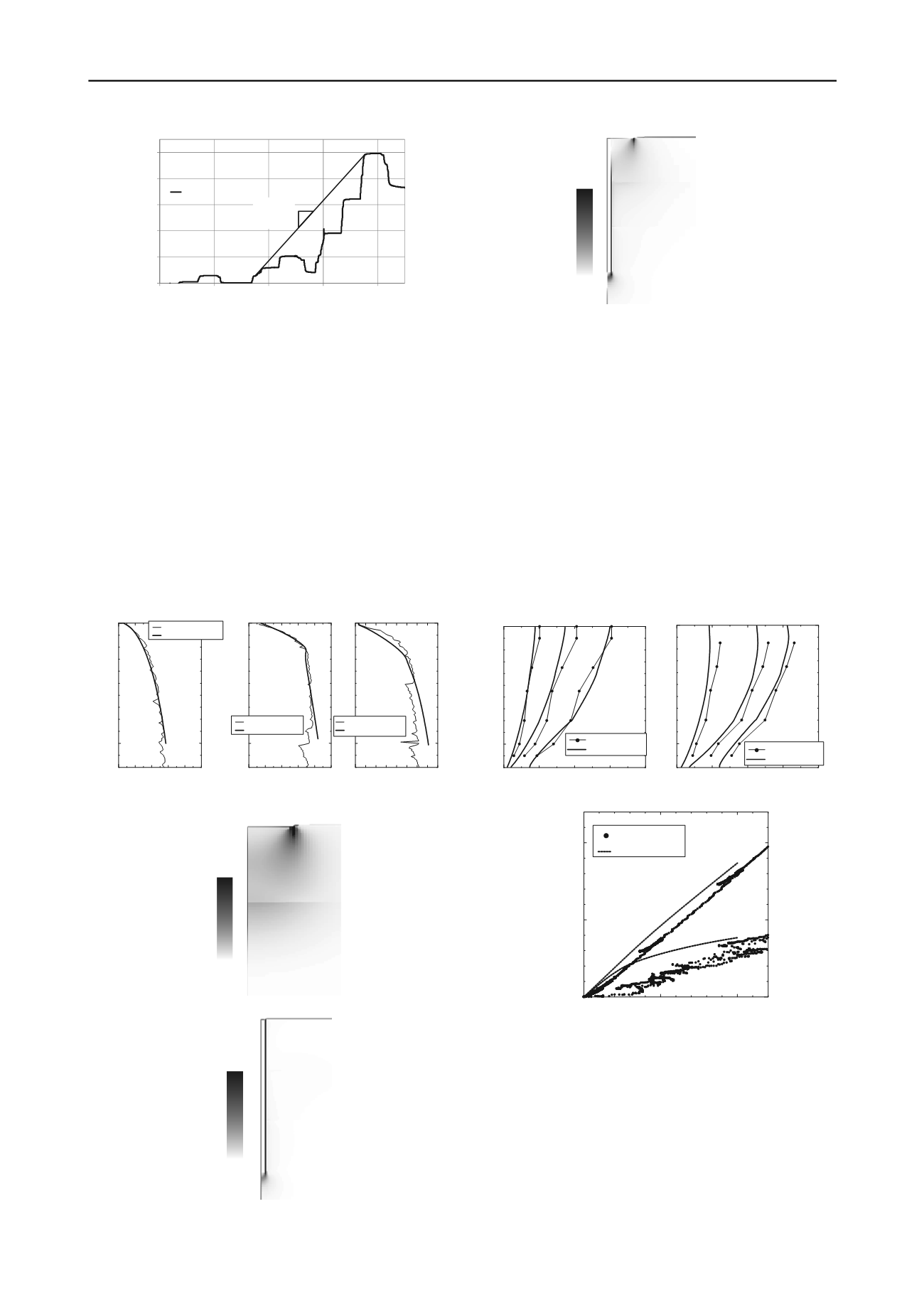
2773
Technical Committee 212 /
Comité technique 212
0
20
40
60
80
100
0
100
200
300
400
Displacement (mm)
Time (min)
Case1
0.01
mm/sec
Figure 5: Experimental displacement versus loading time
4 COMPARISON OF EXPERIMENTS AND
SIMULATIONS
Figure 6 shows both the experimental and simulated results for
the relationship between settlement and load at the center of the
load area. It can be seen that the simulation reproduced the
experimental results in each case, including the initial modulus
and the inflection point for Case 2. Figure 7 shows the shear
strain contours at a settlement of 10 cm. For Case 1, the
distribution of shear strain under the raft appears wedge shaped.
For Case 2, the shear strain around the pile is high because of
friction between the soil and the pile. Shear stain is also high at
the toe of the pile. For Case 3, although the shear strain under
the raft and around the pile is also high, the strain around the
upper part of the pile is not. This is because the friction around
the upper part of the pile is not sufficient to deform the soil
under the raft into a wedge shape.
0
2000
4000
100
0
Load
(kN)
Settlement (mm)
Experimental data
Simulation
0
2000
4000
100
0
Load
(kN)
Settlement (mm)
Experimental data
Simulation
0 2000 4000 6000 8000
100
0
Load
(kN)
Settlement (mm)
Experimental data
Simulation
(a) Case 1 (b) Case 2 (c) Case 3
Figure 6: Relationship between settlement and load
0.0
0.1
(a) Raft
0.0
0.3
(b) Pile
0.0
0.2
(c) Piled raft
Figure 7: Shear strain contours
Figure 8 shows the axial force distribution for loads of 1,000,
2,000, and 3,000 kN on the head of the pile. For Cases 1 and 2,
the simulations reproduce the experimental results. For Case 3,
no increase in axial force occurs from the soil surface to a depth
of 2 m. As noted previously, this indicates that friction around
the upper part of the pile is not effective in deforming the soil
under the raft. Figure 9 shows the relationship between the
vertical displacement at a soil depth of 1.0 m or 4.5 m and the
raft settlement. The measurement point is shown in figure 1. It
can be seen that there is good agreement between the
experimental and simulation results. At a depth of 1.0 m, the
displacement is almost the same as that at the surface, whereas
at 4.5 m, it is consistently less. This is probably due to
horizontal compression or deformation of the soil at a depth of
4.5 m.
0
2000
4000
10
0
Axial Force (kN)
Elevation (m)
Experimental data
Simulation
1000 kPa 2000 kPa
3000 kPa
0
2000
4000
10
0
Axial Force (kN)
Elevation (m)
Experimental data
Simulation
1000 kPa
2000 kPa
3000 kPa
(a) Pile (b) Piled raft
Figure 8: Axial force distribution
5
10
0
5
10
Raft settlement (cm)
Vertical displacement in the ground (cm)
Experimental data
Simulation
-4.5m
-1.0m
Figure 9: Relationship between vertical displacement at
different depths and raft settlement
5 COMBINED BEARING CAPACITY OF PILE AND
RAFT
Figure 10 shows the relationship between the settlement and
load. Here, “Pile + raft (Exp.)” indicates the combined
experimental load of the pile and the raft, “Piled raft (Exp.)”
represents the experimental data for the piled raft foundation
(Case 3) and “Pile + raft (Sim.)” shows the simulation results
for the combined load of the pile and the raft. The simulation
results for the piled raft foundation (Case 3) are omitted because


